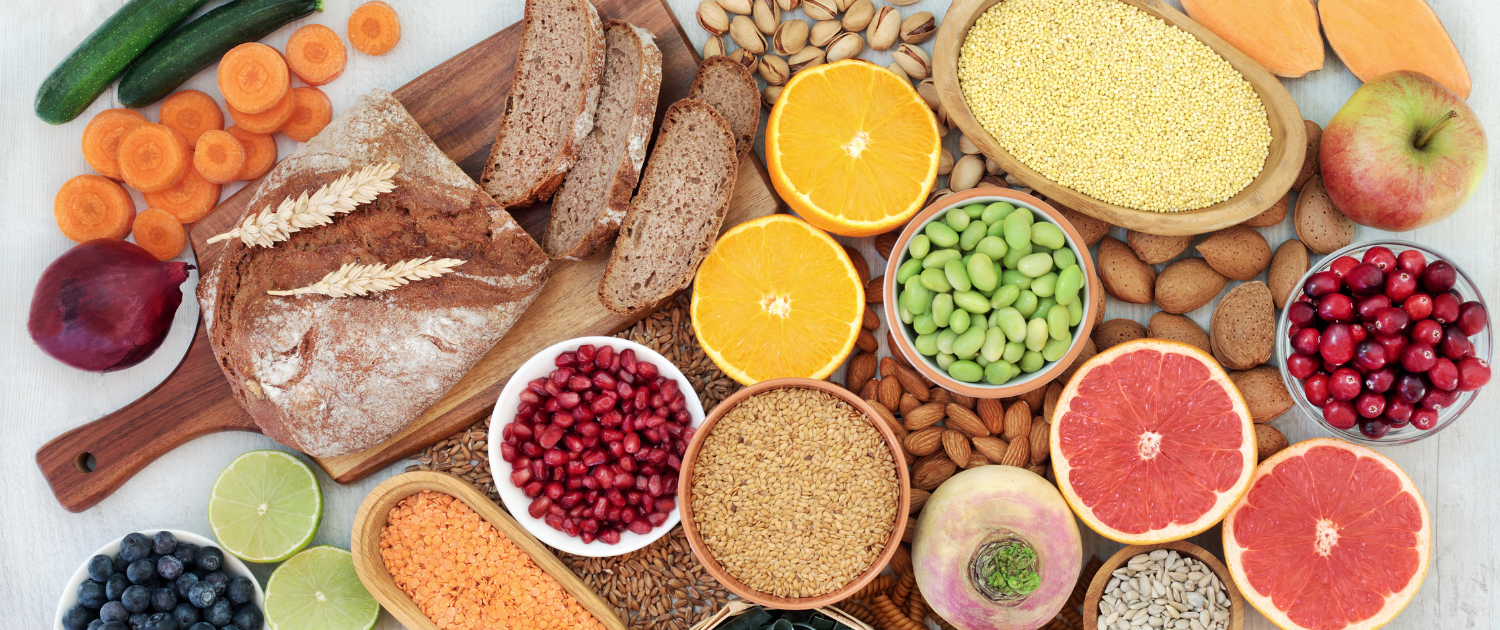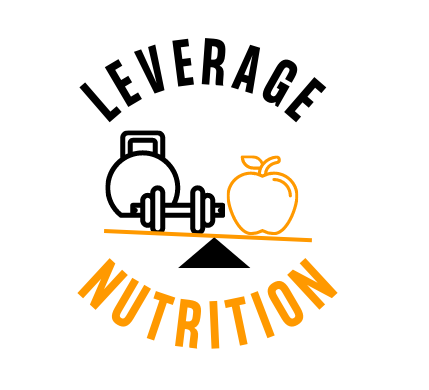
Daniel Neuman, RD, has contributed to information in this blog post.
***
You have probably heard that fibre is important for your health. But, you may have not fully understood why or how much fibre you need daily. This post will review this by highlighting the health benefits of fibre, and give you a better understanding of what an adequate amount of fibre intake per day looks like.
What Is Dietary Fibre?
Dietary fibre is non-digestible carbohydrate found in plant foods like vegetables, fruit, legumes, whole grain cereals, nuts, and seeds. Another way of understanding this: fibre is something we eat but our body can’t breakdown, and there are benefits to this (more on this later).
Fibre can be grouped in two main types – Insoluble and soluble fibre, each type having separate and combined health benefits. Soluble fibre helps control blood sugars and lowers cholesterol. It is found is some fruits and vegetables, and grains like oats and chia seeds (it’s why things like chia pudding and overnight oats absorb water). It is also found in legumes like beans and lentils. Insoluble fibre helps keep you regular. It is found in vegetables and fruit, whole grains, and wheat bran.
How Much Fibre Do You Need?
This article highlights the different recommended amounts, but on average most adults need about 25g per day; this value will change depending on your energy intake requirements (it’s suggested to have 14g for every 1000 calories), which is based on your sex, age, weight, height, and activity level.
Side note: there are no dietary intake recommendations for infants, 1 y of age, because it is assumed that most of the nutrients will be provided by milk for the first 6 mo of life, and there are no data on fiber intake for infants until after 1 y of age.
Health Benefits of Fibre:
- Promote regular bowel movements
- Lower cholesterol, and decreased risk of coronary heart disease (2)
- Diets high in dietary fibre help manage blood sugars more effectively, especially in those with diabetes (12)
- Diets high in dietary fibre can help with weight management, and improve weight loss outcomes
How Can Fibre Help With Weight Loss?
Getting enough fibre is super important – Average fibre intake in the general population is only about half what is recommended by health organizations like Health Canada and the Heart & Stroke Foundation (14g/day versus the recommended 25-38g/day).
Ample research shows that a getting enough dietary fibre, in addition to many other health related benefits, can help with appetite regulation, adhering to diets, and improved weight loss outcomes.
What Else Does The Research Say?
A recent systematic review and meta-analysis of randomized controlled trials (basically, the highest quality study you can have, looking at many well done research studies) found that diets high in dietary fibre improved body weight and waist circumference, especially in overweight and obese adults. Some studies showed increasing fibre helped weight loss independent of how much calories they ate, and that people on high fibre diets stuck with their diet plan longer.
Similarly, two other recent systematic reviews found that dietary pulses (high fibre foods including beans, lentils, chickpeas, and dry beans), as well as soluble fibre supplementation can lead to weight loss even when the diets are not meant to be lower in calories.
The individual research studies on fibre show that dietary fibre may improve your metabolism, improve your gut health (including the bacteria that support digestion), help you stick to your diet longer, and many that look at specific conditions such as heart disease, diabetes, inflammatory bowel disease, constipation, diverticulitis, and more.
If you haven’t been convinced yet of the magic of fibre, just try increasing fibre in your diet and see for yourself! Or connect with a dietitian to see how you can maximize the benefits of increasing fibre in your diet.
Other Common Questions Answered:
Can I just take fibre supplements to ensure I’m getting enough fibre instead?
Well, you can, but you may be missing out on the synergistic and varied benefits of all the different fibres found in so many different foods.
There is a growing market for fibre in the supplement and food fortification industry. However, supplements usually just use one or two inexpensive forms of fibre that allows them to use fibre in their product health claim. Claims that in some cases may be misleading.
Whole foods on the other hand, contain a variety of different fibres you are unlikely to see in these types of products. I recommend to eat more whole foods. Whole foods naturally have a diverse array of fibres, each with their own health benefit.
I suggest to save your money on supplements and instead buy more vegetables, fruits, legumes, nuts, seeds, and whole grains!
What happens when you don’t have enough fibre?
The most notable response to diets providing very low levels of fiber intake is an increase in constipation. However, several negative physiological responses occur in individuals who consume low levels of dietary fiber over time, particularly an increased risk for coronary heart disease.
Can you have too much fibre?
Toxicity: No tolerable upper intake level has been set for dietary fiber (2). However, the IOM suggested that there may be a need for a tolerable upper intake level in the future if supplements or foods with added functional fiber were to become ubiquitous. Very high levels of consumption could lead to reductions in the absorption of some minerals. Yet, it is not thought that this could create mineral deficiencies in areas where diets are not limiting in minerals.
Are all sources of fibre created equal?
Types of fibre out there: Inulin, fructooligosaccharides, Psyllium-containing products, β-D-glucan, Galactooligosaccharides, Polydextrose, Resistant starch (RS2 and RS3)
No. Like mentioned above, you have two main groups of fibre – Insoluble and soluble. And each group many different fibre types within each group, with many different positive effects. For example beta-glucan is one type of soluble fibre found in oats that has been shown to lower cholesterol and improve heart health.
Understanding nutrient label claims
Content claims “source of fibre”, “high source of fibre”, and “very high source of fibre” can be made for foods containing respectively a minimum of 2, 4, or 6 grams of dietary fibre per serving.
General Tips to Get More Fibre
At breakfast:
- Add chia seeds and ground flax (each have about 4g fibre per tbsp) to oatmeal or smoothies
- Top cereal or oatmeal with nuts and/or seeds (eg. pumpkin seeds, or chopped up almonds, pecans, or walnuts)
- Add cinnamon (1.5g fibre in 1 tsp) or cocoa powder (1.8g fibre in 1 Tbsp) to oatmeal or smoothies
At lunch and supper:
- Eat more vegetables (and fruit), nuts, and legumes; these are typically low calorie, nutrient dense, and have a lot of fibre.
- Add chickpeas to pasta
- Add lentils to soup
- Add black beans to chili
With snacks:
- When possible eat a fruit
- Eat more nuts and seeds
- Add berries or kiwi with yogurt
- Apple with cheese
- Banana with peanut butter
- Berries, such as blueberries raspberries blackberries and strawberries.
- Baby carrots with hummus Mini bell peppers with hummus
- Roasted edamame beans
- Air popped popcorn with smoked paprika
- Low-fat plain or Greek yogurt topped with flaxseed
In general:
- Swap regular grains for whole grains (brown rice, quinoa)
- Whole wheat bread for white bread
- Include high fibre foods in your baking, such as bananas or applesauce instead of sugar, or adding in oats, flaxseed, bran flakes, and other whole grains. You could even make a sugarless chocolate zucchini bread.
- Read food nutrition labels – Compare brands of the same type and choose the one higher in fibre.
Sample one day fibre menus
| 25g fibre (Adequate) | 38g fibre (High) | |
| Breakfast | One homemade oat-bran muffinFruit smoothie (one banana, one cup frozen strawberries, and one cup skim milk). | Smoothie bowl: Two cups greek yogurt, 1 cup blueberries, 60g rolled oats and 2Tbsp flax. |
| Snack | One hard-boiled egg and a fruit. | Two cups baby carrots and celery3/4 cup hummus. |
| Lunch | Two cups homemade minestrone soup with 6 whole grain cracker | Two cups white bean and turkey chiliOne medium whole grain pita |
| Dinner | Teriyaki tofu vegetable stirfry (two cups mixed vegetables) with one cup brown rice (or quinoa) and one glass skim milk. | Lemon garlic chicken breast with two cups cup cauliflower/broccoli, and one cup wild rice. |
Take home message:
Good sources of dietary fiber include whole grains, legumes, vegetables, nuts and seeds, and fruits.
Fiber supplements can be used to increase the intake of dietary fiber, however, most experts recommend that fiber should be obtained through the consumption of foods, because this form allows consumption of many micronutrients and bioactive compounds contained in high fiber foods – which provide their own nutritional benefits
Make sure that when increasing fibre in your diet, you drink more water (at least 2-3 litres per day). – This will help prevent constipation.
Appropriate amounts of dietary fibre are only one part of a healthy balanced diet and lifestyle.
Till next time,
-Mike
In text citations will have [1] and hyperlinked to original source, as well as listed below.
- https://www.canada.ca/en/health-canada/services/nutrients/fibre.html
- https://www.heartandstroke.ca/get-healthy/healthy-eating/fibre-and-whole-grains
- https://pubmed.ncbi.nlm.nih.gov/31897475/
- https://www.ncbi.nlm.nih.gov/pmc/articles/PMC6722715/
- https://academic.oup.com/ajcn/article/106/6/1514/4823179
- https://www.ncbi.nlm.nih.gov/pmc/articles/PMC6306953/
- https://pubmed.ncbi.nlm.nih.gov/27030531/
- https://pubmed.ncbi.nlm.nih.gov/31174214/
- https://pubmed.ncbi.nlm.nih.gov/11396693/
- https://www.ncbi.nlm.nih.gov/pmc/articles/PMC6315720/
- https://www.ncbi.nlm.nih.gov/pmc/articles/PMC6073249/
- https://www.unlockfood.ca/en/Articles/Fibre/Getting-more-fibre.aspx
- https://www.unlockfood.ca/en/Articles/Fibre/Focus-on-Fibre.aspx
- https://www.unlockfood.ca/en/Articles/Fibre/?page=2
